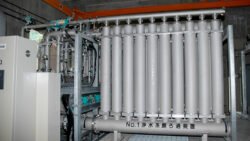bubble-electrospun nanofiber membranes

Title: An In-depth Analysis of Bubble-Electrospun Nanofiber Membranes
Introduction
Bubble-electrospinning (BE) is an advanced and efficient approach towards the mass production of nanofiber membranes. This modern technique has captured the attention of researchers in diversified fields such as textile engineering, biomaterials, biological engineering, nanotechnology, and chemical engineering, among others. The process of BE is a scenario where nanofiber production receives a significant boost, thereby facilitating membrane structure at a nano level. This breakthrough in the field of nanotechnology has introduced a new way to develop and implement advanced materials with highly desirable characteristics. This article will delve into the complexity of bubble electrospun nanofiber membranes, their production process, properties, and applications.
Understanding Bubble-Electrospun Nanofiber Membranes
Bubble-electrospun nanofiber membranes, as the name implies, are fibers generated through the bubble electrospinning process with diameters ranging from a few nanometers to less than a micrometer. The membrane is essentially made up of tangled web-like structures comprising millions of intertwined nanofibers. The advantage of these nanofiber membranes is their high surface area-to-volume ratio, light-weight, excellent mechanical strength and notable porosity, which consequently enhance their functionality in various applications.
Production Process
Bubble electrospinning fundamentally involves ejecting a jet from the surface of a polymer solution forming a Taylor cone induced by a high electric voltage. When the electrostatic force surpasses the surface tension of the polymer solution, a liquid jet is instigated from the Taylor cone towards the collector.
In Bubble electrospinning, bubbles act as the dynamic nozzles, offering numerous jet ejection points. These nanoscale bubbles are created from the Taylor cones’ apex and depend on the applied voltage, solution concentration, viscosity, temperature, and surface tension. By controlling these parameters, it is possible to manipulate the size and morphology of the nanofiber membranes.
Properties of Bubble-Electrospun Nanofiber Membranes
One of the most intriguing properties of the bubble-electrospun nanofiber membranes is the high surface-to-volume ratios, which makes them an ideal candidate for applications requiring a high active surface area. Additionally, their nanoscale features provide them with a high porosity level, enhancing their filtering capabilities.
Mechanically, nanofiber membranes are light-weight yet display high strength. This high strength-to-weight ratio is an essential property for applications requiring lightweight but durable materials, such as aerospace and automotive industries.
Furthermore, due to their unique structure, bubble-electrospun nanofiber membranes present excellent thermal and acoustic insulation properties. They retain these properties even when subjected to a high-temperature environment.
Applications of Bubble-Electrospun Nanofiber Membranes
The unique properties and characteristics possessed by bubble-electrospun nanofiber membranes pave the way for their wide application scope in various sectors.
In the field of biomedicine, the membranes are widely used due to their high surface-to-volume ratio and excellent biocompatibility. They serve as impressive biomimetic scaffolds for tissue regeneration, drug delivery systems, and wound dressings, among others.
One of the significant applications of nanofiber membranes involves waste water treatment and water purification. Their high porosity allows them to effectively trap and filter out various contaminants, making them incredibly useful for removing bacteria, viruses, and chemicals from water.
In the realm of energy, the membranes can be employed in developing advanced battery separators and efficient solar cells due to their insulation properties and high surface area.
They also find application in sensors, air filtration, and protective clothing, where their tiny pore size provides excellent filtering capabilities, while their surface characteristics allow interaction with different chemical and biological species.
Challenges and Future Perspective
While bubble-electrospun nanofiber membranes exhibit remarkable versatility, several challenges need to be navigated. These include the difficulty in achieving a uniform and controlled morphology, ensuring the nanofiber strength, stability, and improving the mechanical properties. Additionally, sustainability and green production practices should be taken into account.
Furthermore, ongoing research to expand the scope of bubble-electrospun nanofiber membranes is promising. New innovations like core-shell, porous, and composite nanofibers are increasingly gaining attention, facilitating the expansion of their application base.
Conclusion
Bubble-electrospun nanofiber membranes are a result of a technological juncture where material science merges with nanotechnology. They present significant application potential considering their unique physical and chemical properties. While challenges are encountered concerning their fabrication and optimization, the broad scope of research and development in this field invariably hints at enormous opportunities lying ahead. Thus, with sustained research interest and advancements, these membranes are poised to revolutionize myriad sectors, ranging from environmental to biomedical.

